THE GREEN MAN IS WORLDWIDE
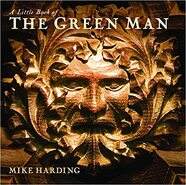 LITTLE GREEN MEN!
LITTLE GREEN MEN!
The ancient figure of the Green Man can be found all over the world and is often represented as just a face many times covered with foliage or with a bearded appearance.
In his A Little Book of The Green Man, author Mike Harding gives examples of green man figures from Lebanon and Iraq dated to the 2nd century. Similar figures exist in Borneo, Nepal, and India.
These are not the only places. The symbol of the Green Man can be found on every continent. The photo below is one found in Hawaii at the I'olani Royal Palace.
In his A Little Book of The Green Man, author Mike Harding gives examples of green man figures from Lebanon and Iraq dated to the 2nd century. Similar figures exist in Borneo, Nepal, and India.
These are not the only places. The symbol of the Green Man can be found on every continent. The photo below is one found in Hawaii at the I'olani Royal Palace.
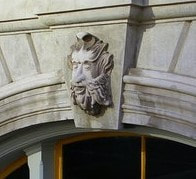 GREEN MAN IOLANI PALACE
GREEN MAN IOLANI PALACE
The photo at the right was taken from the parking lot of the Iolani Palace in Honolulu. This effigy of a Green Man figure is above one of the partially underground windows on the outside of the building.
The figure shows just a head, or even just a face, of a bearded man in bas relief on the center keystone above an old-world style large arched window.
It appears to have its mouth open and perhaps the tongue out Depending on the context, it can mean teasing, disliking, disgust, being silly, angry, rude, or rebellious. It is a symbol of defiance.
The figure shows just a head, or even just a face, of a bearded man in bas relief on the center keystone above an old-world style large arched window.
It appears to have its mouth open and perhaps the tongue out Depending on the context, it can mean teasing, disliking, disgust, being silly, angry, rude, or rebellious. It is a symbol of defiance.
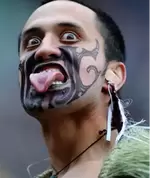 FIERCE COUNTENANCE
FIERCE COUNTENANCE
One well-known example of the gesture of sticking out the tongue is in the Maori war dance, the Haka. The Haka dance is a fierce display of a tribe's pride, strength and unity. Actions include violent foot-stamping, tongue protrusions and rhythmic body slapping to accompany a loud chant.
In Maori culture. Pukana or tongue poking, sticking out the tongue is either used to intimidate, evoke a response, to challenge, to insult, a prelude to a battle or to show the persons confidence, cockiness or the person is giving you cheek
In Maori culture. Pukana or tongue poking, sticking out the tongue is either used to intimidate, evoke a response, to challenge, to insult, a prelude to a battle or to show the persons confidence, cockiness or the person is giving you cheek
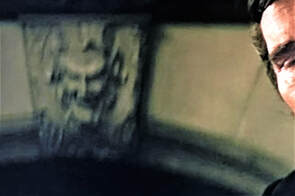 DEVIL GREEN MAN IN THE PALE BLUE EYE
DEVIL GREEN MAN IN THE PALE BLUE EYE
The Green Man is said to be a woodland or nature 'spirit' and is a pagan 'deity'. At the risk of sounding like Bobby Boucher's mamma in The Water Boy, "It's the devil." Plainly, it is.
This 'nature spirit' is still worshiped today in the form of Gaia, Wicca, earth mother goddess, animism, etc.
They worship the creation rather than the creator:
"Who changed the truth of God into a lie, and worshipped and served the creature more than the Creator." Romans 1:25
The depiction to the right is a screenshot from the movie The Pale Blue Eye with Christian Bale and shows a very devil-like greenman above a fireplace. It is very similar to the Green Man at Iolani Palace being also is placed on a keystone above an arched structure.
Again, this figure is found all over the world. It is a (false) 'one world religion': "...The whole world lieth in wickedness." 1 John 5:19
This 'nature spirit' is still worshiped today in the form of Gaia, Wicca, earth mother goddess, animism, etc.
They worship the creation rather than the creator:
"Who changed the truth of God into a lie, and worshipped and served the creature more than the Creator." Romans 1:25
The depiction to the right is a screenshot from the movie The Pale Blue Eye with Christian Bale and shows a very devil-like greenman above a fireplace. It is very similar to the Green Man at Iolani Palace being also is placed on a keystone above an arched structure.
Again, this figure is found all over the world. It is a (false) 'one world religion': "...The whole world lieth in wickedness." 1 John 5:19
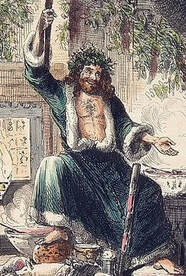 GREEN 'FATHER CHRISTMAS'
GREEN 'FATHER CHRISTMAS'
Parallels have been drawn between the Green Man and various other 'deities' such as Bacchus, Pan, Dionysus, Odin, Lud, Osiris, Nodens, among many others.
Father Christmas, who was often shown wreathed in ivy in early depictions, has been suggested as a similar woodland spirit. In this rendering, he is shown bearded and clothed in green velvet with an ivy headdress and green garland in the background.
This Father Christmas is not the round jolly old elf we are accustomed to seeing, but rather is shown more as a bare-chested and barefooted reveler living the 'good life' surrounded by meats, breads, pies and a bowl of wassail with a roaring fire and a flaming torch.
He is also incidentally in a very similar pose to the demonic Baphomet statue with the right hand raised and the left hand down with the palm open and facing up. The baphomet also is shown with a torch, in the latter case on its head between the horns. It is also a bearded figure as it is a goat's head with a goatée, or goat beard.
Father Christmas, who was often shown wreathed in ivy in early depictions, has been suggested as a similar woodland spirit. In this rendering, he is shown bearded and clothed in green velvet with an ivy headdress and green garland in the background.
This Father Christmas is not the round jolly old elf we are accustomed to seeing, but rather is shown more as a bare-chested and barefooted reveler living the 'good life' surrounded by meats, breads, pies and a bowl of wassail with a roaring fire and a flaming torch.
He is also incidentally in a very similar pose to the demonic Baphomet statue with the right hand raised and the left hand down with the palm open and facing up. The baphomet also is shown with a torch, in the latter case on its head between the horns. It is also a bearded figure as it is a goat's head with a goatée, or goat beard.
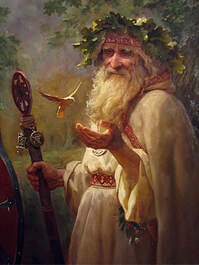 DRUID MERLIN IN GREEN IVY
DRUID MERLIN IN GREEN IVY
The above depiction of Father Christmas also resembles Merlin, another bearded figure, who was a Druid wizard, or 'wise man'. He is shown here with a wooden staff and a garland of green ivy on his head.
Druids also worshiped nature, especially the forest and its trees. In fact, many of our Christmas 'traditions' come from Druid worship practices such as the use of holly, ivy, mistletoe, and other evergreens.
The Druids believed in a supreme god, whom they called Be' al, (Ba'al) meaning "the source of all beings." The symbol of this supreme being was fire. But the Druids also worshiped many lesser gods.
In Celtic times, druids observed the festival of Alban Arthan (also known as Yule) at the time of Winter solstice. They gathered mistletoe from oak trees, in an attempt to ward off evil spirits and grant them good luck.
Druids would often practice their 'rites' in oak groves.
The Druid religion was practiced by ancient Celtic tribes that populated Ireland and parts of Europe. This religion worshiped Samhain, the Lord of Darkness. Some writings also speak of Samhain as the “Lord of the Dead”.
Druids also worshiped nature, especially the forest and its trees. In fact, many of our Christmas 'traditions' come from Druid worship practices such as the use of holly, ivy, mistletoe, and other evergreens.
The Druids believed in a supreme god, whom they called Be' al, (Ba'al) meaning "the source of all beings." The symbol of this supreme being was fire. But the Druids also worshiped many lesser gods.
In Celtic times, druids observed the festival of Alban Arthan (also known as Yule) at the time of Winter solstice. They gathered mistletoe from oak trees, in an attempt to ward off evil spirits and grant them good luck.
Druids would often practice their 'rites' in oak groves.
The Druid religion was practiced by ancient Celtic tribes that populated Ireland and parts of Europe. This religion worshiped Samhain, the Lord of Darkness. Some writings also speak of Samhain as the “Lord of the Dead”.
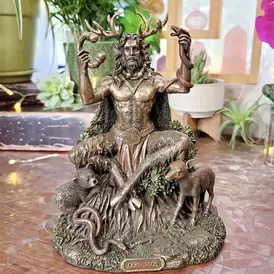
Like Merlin, the Green man is also associated with Cernunos the stag horned god. It is also tied to tree worship, growth & rebirth, harvest, crops, leaves, ouroborus, the circle of life, cycles, seasons, dragon, serpent, et al.
Cernunnos, (Celtic: “Horned One”) in Celtic religion, an archaic and powerful deity, widely worshiped as the “lord of wild things.” He is the Horned God of the Witches (not a good thing, by the way).
This statue shows him with not only horns, but also a serpents (one in his left hand and one on the ground below his hooves) as well as woodland animals such as a bear cub and a fawn.
His cross-legged sitting position also resembles the baphomet and pan, who is half man and half animal as well. (While baphomet is half goat, the cernunnos is half stag.) The face and head of the statue above is that of a man with the ears and antlers of a stag.
The long flowing hair and beard is very reminiscent of that often shown for the Green Man. He is leaning against the trunk of a tree with green foliage growing at the base, up the sides and behind him.
Cernunnos, (Celtic: “Horned One”) in Celtic religion, an archaic and powerful deity, widely worshiped as the “lord of wild things.” He is the Horned God of the Witches (not a good thing, by the way).
This statue shows him with not only horns, but also a serpents (one in his left hand and one on the ground below his hooves) as well as woodland animals such as a bear cub and a fawn.
His cross-legged sitting position also resembles the baphomet and pan, who is half man and half animal as well. (While baphomet is half goat, the cernunnos is half stag.) The face and head of the statue above is that of a man with the ears and antlers of a stag.
The long flowing hair and beard is very reminiscent of that often shown for the Green Man. He is leaning against the trunk of a tree with green foliage growing at the base, up the sides and behind him.
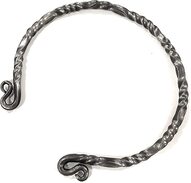 CELTIC NECK TORC
CELTIC NECK TORC
The Green Man figure above is also shown clutching a torc, a large rigid neck ring in a single piece of metal worn as a pagan symbol of protection, power, and worship.
This was an important piece of Celtic jewelry that was a powerful symbol, perhaps representing the wearer's free-born status, and was often complemented with additional rings worn about the arms and wrists.
He is in fact shown with one also around his neck along with additional neck and arm pieces done in a Celtic knot design. The neck piece is also adorned with two medallions on each side in the shape of a pentagram.
This was an important piece of Celtic jewelry that was a powerful symbol, perhaps representing the wearer's free-born status, and was often complemented with additional rings worn about the arms and wrists.
He is in fact shown with one also around his neck along with additional neck and arm pieces done in a Celtic knot design. The neck piece is also adorned with two medallions on each side in the shape of a pentagram.
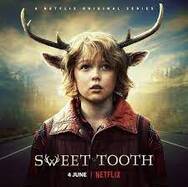 SWEET TOOTH DEER HYBRID
SWEET TOOTH DEER HYBRID
The half-stag, or half-deer, theme is also seen in the Netflix series Sweet Tooth which is based on a DC comic about a boy who is born with the ears and antlers of a deer.
There are many themes in this story that are reminiscent of the myth of the Green Man. In Sweet Tooth, Gus, a young boy with deer-like features, lives a quiet life deep in the woods with his father.
He is a woodland dweller like the GreenMan, and he learns many things while he is there, from medical care to religious prophecy. Both of these figure in Green Man lore as well, especially the religious or spiritual aspect.
As the Green Man is also a 'type' of the Baphomet figure, the medical aspect also applies since it is often shown with a caduceus, or staff of Hermes, medical symbol between its lap. In fact, the premise of the SweetTooth saga is based upon a medical theme in that the story centers around society having collapsed due to a viral pandemic.
There are many themes in this story that are reminiscent of the myth of the Green Man. In Sweet Tooth, Gus, a young boy with deer-like features, lives a quiet life deep in the woods with his father.
He is a woodland dweller like the GreenMan, and he learns many things while he is there, from medical care to religious prophecy. Both of these figure in Green Man lore as well, especially the religious or spiritual aspect.
As the Green Man is also a 'type' of the Baphomet figure, the medical aspect also applies since it is often shown with a caduceus, or staff of Hermes, medical symbol between its lap. In fact, the premise of the SweetTooth saga is based upon a medical theme in that the story centers around society having collapsed due to a viral pandemic.
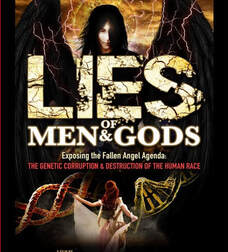 FALLEN ANGELS & HUMAN WOMEN
FALLEN ANGELS & HUMAN WOMEN
This disease is known as the Sick (or the H5G9 virus), making this story a reflection of our similar dealings with a 'pandemic' in recent times. One of the aims of this article is to demonstrate that these demonic themes are all around us everywhere.
The 'Sick' wipes out most of the world's human population leading to the mysterious emergence of hybrid babies that are born part human and part animal with no one agreeing which came first, the virus or the hybrids.
The idea of 'hybrids' is another theme in pagan and Greek mythology, stemming from the idea in the Bible of fallen angels mating with human women creating hybrids known as the Nephilim, or the Giants. They were also known as 'the mighty men of old' the Titans.
There is additionally the theory that there was genetic manipulation between fallen angels and animals as well going on during the time before the flood of Noah. The book cover pictured above sums it up very well:
LIES OF MEN & GODS - "Exposing the Fallen Angel Agenda: The Genetic Corruption & Destruction of the Human Race." This has been the goal from the very beginning, and continues to this day.
The 'Sick' wipes out most of the world's human population leading to the mysterious emergence of hybrid babies that are born part human and part animal with no one agreeing which came first, the virus or the hybrids.
The idea of 'hybrids' is another theme in pagan and Greek mythology, stemming from the idea in the Bible of fallen angels mating with human women creating hybrids known as the Nephilim, or the Giants. They were also known as 'the mighty men of old' the Titans.
There is additionally the theory that there was genetic manipulation between fallen angels and animals as well going on during the time before the flood of Noah. The book cover pictured above sums it up very well:
LIES OF MEN & GODS - "Exposing the Fallen Angel Agenda: The Genetic Corruption & Destruction of the Human Race." This has been the goal from the very beginning, and continues to this day.
The Druid religion was practiced by ancient Celtic tribes that populated Ireland and parts of Europe. This religion worshipped Samhain, the Lord of Darkness. Some writings also speak of Samhain as the “Lord of the Dead”.
Osiris, ruler of the underworld and of rebirth and regeneration, was typically shown with a green face.
Osiris, ruler of the underworld and of rebirth and regeneration, was typically shown with a green face.